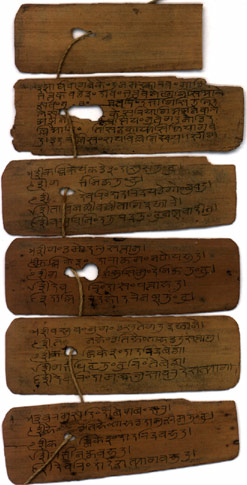 Palm leaf books are a traditional book form of Southeast Asia and India. They are long, narrow dried and painted palm leaves, strung together on a cord. Being vertical they are a nice alternative to the omnipresent horizontal accordion fold book. (The one to the right is from the Columbia University Library.)
Palm leaf books are a traditional book form of Southeast Asia and India. They are long, narrow dried and painted palm leaves, strung together on a cord. Being vertical they are a nice alternative to the omnipresent horizontal accordion fold book. (The one to the right is from the Columbia University Library.)
![]() I’ve been thinking about palm leaf books this week (and what I might do with the vertical format in general) after reading Holland Cotter’s NY Times review of an exhibit of one especially beautiful example in the exhibit Early Buddhist Manuscript Painting: The Palm-Leaf Tradition at the Metropolitan Museum of Art in NY. Cotter says “sturdy and compact, they weigh next to nothing. The collapsible format protects them from dirt and light … Such practical features — size, resilience, portability — help explain why … the illustrated book was popular in India between the 10th and 13th centuries. And they suggest why such books and their illustrations have survived into the present, while painting in more perishable media has not … The palm-leaf sheets varied in length, but were seldom more than a few inches wide. They were stacked like slats in Venetian blinds and bound by threads passed through two holes in the center of each sheet. Rather than forming a single surface, as in modern palm-leaf paintings, the sheets in books were meant to be seen one at a time. The sequence for viewing them was determined by the flow of an inscribed text, which was punctuated with tiny paintings.”
I’ve been thinking about palm leaf books this week (and what I might do with the vertical format in general) after reading Holland Cotter’s NY Times review of an exhibit of one especially beautiful example in the exhibit Early Buddhist Manuscript Painting: The Palm-Leaf Tradition at the Metropolitan Museum of Art in NY. Cotter says “sturdy and compact, they weigh next to nothing. The collapsible format protects them from dirt and light … Such practical features — size, resilience, portability — help explain why … the illustrated book was popular in India between the 10th and 13th centuries. And they suggest why such books and their illustrations have survived into the present, while painting in more perishable media has not … The palm-leaf sheets varied in length, but were seldom more than a few inches wide. They were stacked like slats in Venetian blinds and bound by threads passed through two holes in the center of each sheet. Rather than forming a single surface, as in modern palm-leaf paintings, the sheets in books were meant to be seen one at a time. The sequence for viewing them was determined by the flow of an inscribed text, which was punctuated with tiny paintings.”
![]() Several years ago, I made a book loosely based on the palm leaf (see it here). There’s instructions for making them here.
Several years ago, I made a book loosely based on the palm leaf (see it here). There’s instructions for making them here.
